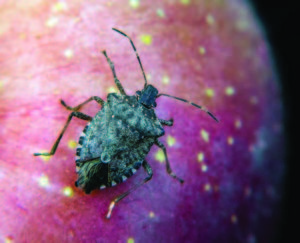Pest Alert: Brown marmorated stink bug
go.ncsu.edu/readext?645794
en Español / em Português
El inglés es el idioma de control de esta página. En la medida en que haya algún conflicto entre la traducción al inglés y la traducción, el inglés prevalece.
Al hacer clic en el enlace de traducción se activa un servicio de traducción gratuito para convertir la página al español. Al igual que con cualquier traducción por Internet, la conversión no es sensible al contexto y puede que no traduzca el texto en su significado original. NC State Extension no garantiza la exactitud del texto traducido. Por favor, tenga en cuenta que algunas aplicaciones y/o servicios pueden no funcionar como se espera cuando se traducen.
Português
Inglês é o idioma de controle desta página. Na medida que haja algum conflito entre o texto original em Inglês e a tradução, o Inglês prevalece.
Ao clicar no link de tradução, um serviço gratuito de tradução será ativado para converter a página para o Português. Como em qualquer tradução pela internet, a conversão não é sensivel ao contexto e pode não ocorrer a tradução para o significado orginal. O serviço de Extensão da Carolina do Norte (NC State Extension) não garante a exatidão do texto traduzido. Por favor, observe que algumas funções ou serviços podem não funcionar como esperado após a tradução.
English
English is the controlling language of this page. To the extent there is any conflict between the English text and the translation, English controls.
Clicking on the translation link activates a free translation service to convert the page to Spanish. As with any Internet translation, the conversion is not context-sensitive and may not translate the text to its original meaning. NC State Extension does not guarantee the accuracy of the translated text. Please note that some applications and/or services may not function as expected when translated.
Collapse ▲
image by Steve School
The brown marmorated stink bug (BMSB, Halyomorpha halys) is an invasive insect native to eastern Asia that entered the U.S. around the mid-1990s. The BMSB is known to feed on over 100 host plants, including tree fruits, vegetables, and row crops. These insects are not harmful to people; they do not bite, sting, or bore into structures.
Once the BMSB emerges in the spring, it goes through three life stages: egg, nymph, and adult. As temperatures decrease in fall and day length shortens, the BMSB enters diapause. During this time, they begin to conserve energy and look for a place to spend the winter.
Stink bugs have a hard exoskeleton making it difficult to control this pest chemically. Plants can tolerate some damage from pests, and using nonchemical methods may be a better option for managing the BMSB. Because BMSBs are attracted to lights, turning off unnecessary lights or lights around the entrance of your home can deter them from entering. Additionally, exclude them from entering the home by checking for cracks around doors and windows, air conditioners, exhaust fans, and other openings. Seal any cracks. If the BMSB has become a pest in your late summer or fall garden, you can exclude them by using a lightweight row cover over your vegetables during their peak feeding times. It is important to note that row covers left on for extended periods of time do need to be removed periodically to allow for pollination to occur. Adult BMSBs are good candidates for hand removal, which includes the removal of egg masses from the undersides of leaves and placing the insects into a bucket containing an inch of soapy water. When you remove BMSB’s from plants, they are likely to emit a foul odor. Protect your hands by wearing gloves.
— Amy Ballard
Additional interesting articles are linked from the index
Extension Gardener Newsletter


